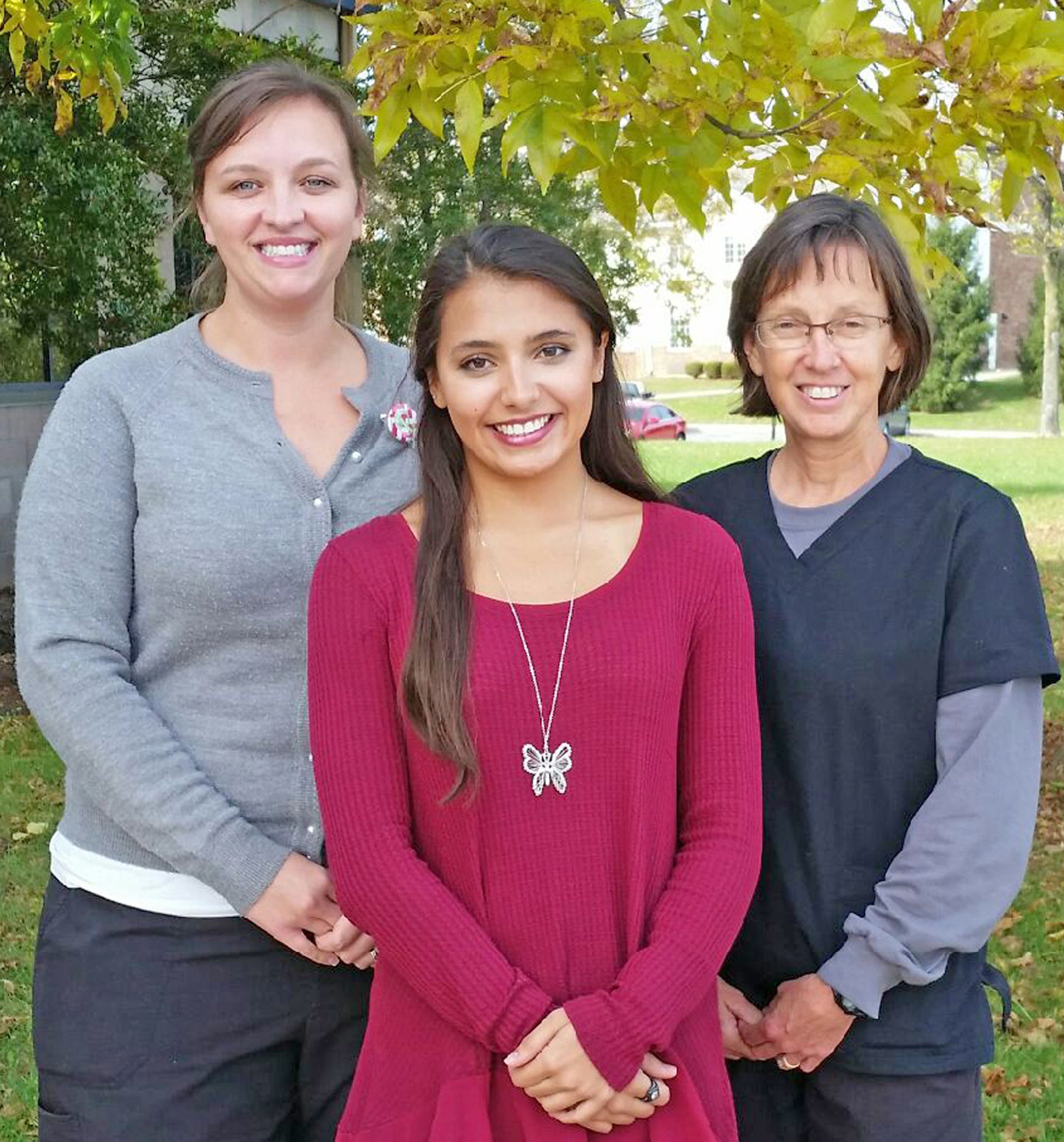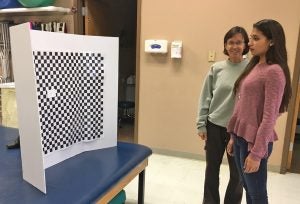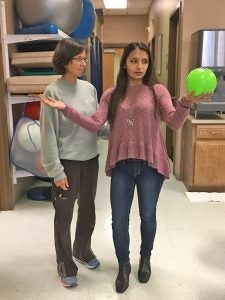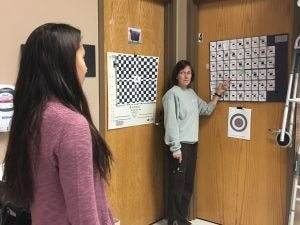Teen navigates concussions with help of therapies
Published 9:23 am Monday, November 6, 2017

- Kendra Peek/kendra.peek@amnews.com Bethany Berry, speech language pathologist, left, and Donna Anderson, physical therapist, right, have worked with Natalie Hayes, center, a 17-year-old who has sustained two concussions and two head traumas since she was 15.
New concussion treatment available through McDowell Wellness
Natalie Hayes was 15 when she sustained her first concussion — the first of two and two head traumas — and it’s been a long road on the way to recovery. The first time, when she was a freshman, she was running on a treadmill.
“I was 15 and I fell across the track. The track kept going, of course. My chin caught the bookshelf behind me,” Hayes said. “At first, I didn’t realize how severe of an injury it was.”
She was diagnosed with a concussion five days later, during spring break. Within a few weeks of the injury, Hayes lost the ability to read.

Photo submitted
Donna Anderson, physical therapist at the McDowell Wellness Center, works with Natalie Hayes, right, a 17-year-old student who has sustained two concussions and two head traumas between her freshman and senior years of high school. Anderson has a certification in working on post-concussive therapies.
“The connection between my eyes and my brain was damaged. I wasn’t able to focus on the words in front of me,” she said.
To have a concussion, it doesn’t have to be a direct hit to the head, said Bethany Berry, a speech language pathologist at McDowell Wellness Center. It can be a hit to another part of the body, with “impulsive forces transmitted to the head.”
You also don’t have to lose consciousness, she said, and that it doesn’t happen in 90 percent of cases.
Donna Anderson, a physical therapist at McDowell Wellness Center, said those with post-concussive syndrome are more likely to show signs of dizziness at the time of the injury, and that post-concussive disorder is most likely to appear in those with a history of migraines and anxiety disorders, in women and in adolescents.
Symptoms include foggy-headedness, fatigue, headache, nausea, dizziness or vertigo, visual disturbance, sensitivity to light and noise, cognitive deficits with concentration or memory, sleep disturbance and, like Hayes, problems with their sense of balance.
Because of the symptoms she dealt with after the fall, Natalie spent the whole year wearing sunglasses.
“A classmate of mine, I took off my glasses for biology lab, because we were looking through microscopes, and she was like, ‘Oh my gosh, I forgot what your eyes looked like,’ because that’s how long I had been wearing sunglasses,” Hayes said.
Her processing was slow, that made it difficult to take in all of the information around her and to be able to explain what she was feeling to others.
“That made it difficult for the recovery process, especially when the first concussion doctor told me, ‘It’ll get better, just give it time.’”
It was 10 months after her accident and Natalie’s recovery had gotten “stagnant.”
“I had headaches every day and I was in pain more than I was not,” she said.
Hayes was an avid swimmer prior to the concussion, and has continually worked to get back to that level. It was during practice that she was hit with a real need to find a different doctor.
“I was at swim practice and I kind of went into shock,” Hayes said, blaming overstimulation.
She said, “This was a big wake up call that we needed to seek different avenues.”
The athletic trainer at Boyle County High School, Jeremy Johnson, referred Natalie to Dr. Tad Seifert in Louisville; he was the seventh doctor they had talked to.
That was January 2016.
“That was a turning point. He opened up and gave me the tools to help me get better. That’s when I started going to (therapy),” she said.

Photo submitted
Donna Anderson, physical therapist at the McDowell Wellness Center, works with Natalie Hayes, right, a 17-year-old student who has sustained two concussions and two head traumas between her freshman and senior years of high school. Anderson has a certification in working on post-concussive therapies.
Natalie did do vision therapy in Versailles, but the bulk of her therapy has been done at McDowell Wellness Center with Anderson and Berry.
It was seeing people like Natalie that inspired Anderson to see what more she could learn about post-concussive syndrome, which result in about 20 percent of individuals with concussions. Those are the ones, like Natalie, who don’t see resolution of their symptoms within a few days or weeks after the injury.
Those numbers are in the millions, said Berry, who has worked for McDowell Health since 2010.
That led Anderson to get a certification in Concussion Management in April 2017. Prior to that, Anderson, who has worked for McDowell Health since 1992, was a certified vestibular specialist.
“I was seeing referrals for dizziness and vertigo and it wasn’t necessarily related to the inner ear. I was realizing it was related to concussions,” she said.
There was a gap in what patients were being referred for and what they actually presented with, said Berry.
Anderson further clarified, and explained they’d get a referral for dizziness or vertigo, and when they’d dig into the cause, they began to realize it was often happening after falls.
Studying concussions is still a new field and there are very few in the state who treat them in the way Anderson is certified to do. A lot of doctors still struggle with diagnosing concussions.
Concussions, Berry said, don’t show up on MRIs or CT-scans. They are diagnosed based on the symptoms, but so much of the time, the solution is to “give it time.”
“We’re having patients come in, even years later, with concussion symptoms and they’re having persistent difficulty,” Berry said. Five out of 10 concussions, she said, go unreported.
Anderson said if someone isn’t recovering within a few weeks, they can offer tips beyond resting to prevent prolonged recovery.
“The symptoms are there, but they’re … not diagnosing that’s what it is. It’s a diagnosis of symptoms and they’re not pinpointing what it really is,” Anderson said.
It will require more education for the public and for physicians, to really help those with post-concussive syndrome to realize what the cause is, she said. Ultimately, they want people to be able to fully return to a normal work life and normal activities with as few symptoms as possible.
For those who have dealt with post-concussive syndrome for years without realizing it, being able to do those normal things again is huge, Berry said.
There’s a lot of attention to sports-related concussions, they said, but the reality is, most concussions come from falls and car wrecks. Like Hayes.
…

Photo submitted
Donna Anderson, physical therapist at the McDowell Wellness Center, works with Natalie Hayes, a 17-year-old student who has sustained two concussions and two head traumas between her freshman and senior years of high school. Anderson has a certification in working on post-concussive therapies.
Hayes was continuing to improve and was close to being released when she had her first setback in April 2016.
“We had a car accident — someone hit us from behind. At the time, I had my foot propped up on the dash, so it was Donna I went to for therapy on my knee, too. I had whiplash and re-injured myself,” she said.
The teen was facing a second concussion, dealing with noise sensitivity this time, versus the light sensitivity she faced the first time. She also struggled with memory and processing again, and her vision was damaged again.
“I basically had to start over,” Hayes said.
Hayes said she has no doubts in her therapy from Berry and Anderson, who she knew prior to sustaining her first injury. Anderson was her cross country coach in middle school and used to be a competitive swimmer, so she understands, the teen said, what it takes to get to that level.
Each time she’s been injured, the teen has worked to be able to compete again — Hayes holds five school records, three individuals and two relays; a collegiate record at Centre’s pool; has won seven state championships; and was training to get into Olympic trials.
She had even gotten back to that level after the first injury, said her mom, Rhonda Hayes.
“We were on the way home, we were in the car, and she said, ‘I feel so good and I am swimming so well.’ This was the night we had the car (crash),” Hayes’ mom said.
“That was pretty hard to swallow. It makes you feel fragile,” said Hayes. “I was not driving. It was not my mother’s fault. It’s the kind of thing that makes you look at things — I can do everything right and still have to deal with the consequences of someone else’s actions. That was something I had to work through.”
The teen credits some of that to Anderson and Berry, too.
“Not only are they my therapists — speech and vestibular — but they made this process a lot better, a lot less miserable than it could have been,” she said with a smile.
She started again, getting back into the pool. First, she did 10 minutes.
“I could do 10 minutes,” Hayes said, slight frustration in her voice.
Ordinarily, Hayes swims for a team in Louisville, Lakeside, four days a week, and the other days at the pool at the Wellness center with her twin brother, Hunter.
“I could add two minutes everyday. That was, oh my gosh, driving me crazy,” she said. “My neurologist let me do that amount of time basically for my mental health, because I love swimming.” Her mom said they allowed that because they wanted her to try to continue doing some exercises, to keep moving.
Hayes said she liked doing the exercises, because that was something she could control.
“I would do them everywhere. Everything in life was therapy,” she said.
Rhonda Hayes said, “I never once had to ask her if she was doing her therapy. She always did them because she wanted to get better. That was absolutely in her control.”
She had worked up to a full practice, and had been doing three weeks of full practice when she competed in the state championships.
“I got second. I was very close to my best time, which was pretty encouraging,” Hayes said.
It was about six months after the wreck, on Sept. 7, 2016, when, through a freak accident, Hayes ran into the garage door as it was coming down.
“It’s like the most random thing ever,” she said, smiling. “I just ran into it.”
It was one morning before school, the teen was in a rush to get out the door because they were running late. It hit near the top of her head.
She can laugh at the absurdity of it now, but said it caused another concussion and brought motion sickness with it.
Her mom can joke, too, and said people will send them photos of helmets and other things because of the number of concussions. Hayes said her doctor joked she needed a helmet like preemie babies wear, but “unfortunately they don’t protect against concussions.”
“It wouldn’t really help me much,” she said.
All the usual symptoms returned with the “mild trauma,” which wouldn’t have been as bad if she hadn’t had two previous concussions.
“I wasn’t able to dive, so that kept me out of competing for a while,” Hayes said. It was a stressful time, she said, because recruiting picks up during the junior year of college.
“It’s frustrating for me, because I have times that are good enough to go to Division I colleges. I was contacted by several big name colleges,” Hayes said. “(At the time) I’m not even in the pool. They wouldn’t like that.”
They visited the University of Kentucky, for one, and were supposed to attend a football game but couldn’t because it would be too overstimulating for Hayes. She continued with therapy, school and swimming, and continued getting better. By December, Hayes had gotten through winter training and back into competing.
Then, on Jan. 7, she was swimming in the pool at practice when a teammate swam into her.
“It was one of those fluke things, it’s not uncommon,” Hayes said.
But, for a normal individual, it wouldn’t have had the impact it did on Hayes, setting her back again.
“That was a pretty traumatic injury in itself. I had to take six months off of swimming, I was homebound for school … My vestibular system was totally wrecked,” she said.
She was constantly motion sick and had to wear patches to help.
…
Hayes said she’s changed so much as a result of the concussions. For one, she had to learn to accept a change in her IEP, a plan at the school that includes how much time she needs to do homework and take tests.
“That was another thing I had to come to grips with. This is something I never had a need to do before and now I do. This is something I had to communicate to my teachers on a daily basis,” Hayes said. She said Berry helped a lot with navigating that.
She also has to sleep more, and takes naps a lot.
Berry calls her driven, and said they had to talk to her about not pushing herself too much. “We had to reign her in,” she said.
“One of the hardest things was realizing I can’t do everything the same way I was used to,” Hayes said.
Berry said for now, that’s something she’s had to adjust to, but that it won’t always be like that.
Rhonda Hayes said she and Hayes’ dad, Mark, have to reign her in. Something like going to the fair or the movies is still not possible for Natalie, because there’d be too much overstimulation. Hayes also can’t watch too much television in a row, but is encouraged to watch some, because it’s good for her therapy.
For a while, Hayes had to stay away from computer screens, too, but she can use it on a limited amount now. She’s had to work on strengthening her “divided attention,” too, by listening to lyrical music while working on homework. They’d also work on that by bringing in both Berry and Anderson to do both types of therapies at the same time.
Hayes is back to swimming, too. She did some coaching and competing this summer and hopes to compete this winter.
Returning to school in August was tough. Rhonda Hayes said her daughter had a two-week migraine after school started and they eventually had to go to infusion therapy to get it broken up.
She’s made her plans for after school, too, and has decided to go to Emmanuel College in Georgia. She has a full ride to the college, and will go there to swim.
She’s grateful to her coaches, therapists, family and mentors. Hayes said she’s grateful to her twin brother, Hunter, who has grown a lot more protective of her through all of this.
Driving is not something she’s tried, although the teen has a license. The overstimulation is the concern, and her mom said they appreciate that Hayes realizes these things and doesn’t push. Her brother drives her around a lot, she said, and is also an avid swimmer. He made the decision to go to Emmanuel College, too.
“Now he can continue to drive me around,” she said, laughing. “He’s a great brother.”
…
Going through this has given her perseverance, Hayes said.
“I’m not the same person I was before this. That was something I had to come to grips with, too. I can still be proud of who I am — not many people have been able to do all of the things I did, going through this recovery,” she said.
Berry said Hayes’ attitude made a big difference. Despite her absences and adjustments at school, she’s maintained a 4.0 GPA.
“I have to give a shout out to Boyle County. They have been absolutely phenomenal,” Rhonda Hayes said. “Not that they’re giving her anything. She still has to work very hard — she’s taking AP Calculus.”
“Just because you can’t auditorily process some information, doesn’t mean you can’t process complex information. It’s those accommodations … That’s how (Natalie) has to be able to navigate the waters,” Berry said.
It’s possible the migraines will go away, but it’s hard to know for sure. Natalie said she spoke to Dr. Seifert about it, who said they’d like persist until early adulthood. She keeps an eye out for the triggers, and they address it as soon as she notices, so it doesn’t get worse. But, “I’ve seen improvements already.”
Rhonda Hayes said, “She can’t stop living her life, but, honestly, I’m not going to lie to you. I do a lot of praying.” She said the whole process has been traumatic for the family, wondering and worrying. But they believe she will get better.
“It’s been overwhelming at times, with the worry and the unknown,” Rhonda Hayes said. “Every little thing, we celebrate. She woke up without a headache, we celebrate. She made the whole practice, we celebrate.”
Natalie Hayes has been inspired by this, and plans to study neuroscience in college — but not concussions.
“I couldn’t separate myself from it,” she said.
She’s more interested in the research of neuroscience, and how little is still known about the brain. Prior to the concussions, she wanted to study architecture.
“I have more conviction with who I am and what I want to be,” Hayes said.






